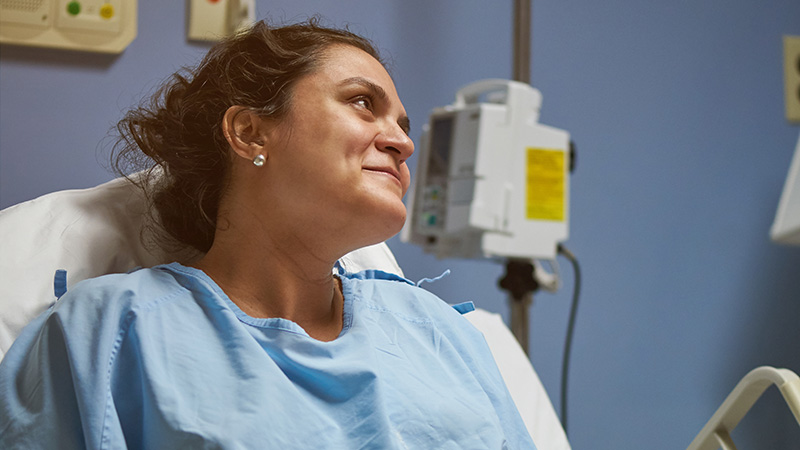Northeastern Vermont Regional Hospital (St. Johnsbury, VT) is one of only two Vermont hospitals certified Baby-Friendly by the World Health Organization. This designation illustrates NVRH’s commitment to providing compassionate care in its labor and delivery unit. To maintain these high standards, the health system realized that ensuring continuity between pre- and postpartum care would be a necessity for its MEDITECH EHR.
That’s why NVRH chose to expand its EHR with MEDITECH’s then newly developed Expanse Labor and Delivery solution; the high level of system integration would enable clinicians to provide care more efficiently throughout the entire continuum.
Improving continuity of care
Previously, NVRH had different systems in the labor and delivery unit and the hospital, which posed some challenges with continuity of care as patients transitioned from labor to postpartum.
When MEDITECH announced the development of the Labor and Delivery solution, NVRH jumped at the opportunity to be an early adopter and provide better connected care. The organization wanted a solution that would easily share a mother’s record from labor to postpartum, keeping the transition safe and seamless.
Now, a mother’s documentation flows discretely to newborn charts, allowing previously siloed data to be recalled in a clinically meaningful way.
Implementation process and insights
As an early adopter of Labor and Delivery, NVRH worked with MEDITECH to identify helpful points of integration. For example, during the implementation process, NVRH discovered the advantage of connecting prenatal records with MEDITECH Expanse Ambulatory.
Hospital staff and MEDITECH’s Development team collaborated on data capture changes to enhance the flow of information between Ambulatory and Labor and Delivery. With a successful Expanse implementation under her belt, Clinical Informaticist Donna Laferriere, RN, brought her MEDITECH product knowledge to the project.
“As I was building the L&D templates, it just made sense to bring in the prenatal information,” said Laferriere.
Laferriere knew that these templates needed to pull in critical Ambulatory information from previous months’ visits to provide a clear story for future care interactions.
“I saw it all as a big jigsaw puzzle covering multiple care spaces. But by following that data, where it comes from and where it’s headed, we can cater the information to our caregivers, showing only what they need to see. This was crucial for us.”
NVRH targeted two other important areas of connectivity:
- MEDITECH’s fetal monitor interface pulls fetal monitoring data into the EHR.
- Bidirectional integration feeds the mother’s record into the newborn’s chart prior to the first pediatric visit.
Streamlined workflows
During the COVID-19 pandemic, NVRH underwent a virtual LIVE to ensure they could optimize usage within weeks.
“Usually when you implement something, you have weeks of putting out fires. But after just two weeks post go-LIVE, we had already started optimizing,” said Laferriere. “I honestly haven’t heard any negative feedback. It’s rewarding to see people finding value in what we’ve done.”
The streamlined workflows enabled by the new Labor and Delivery solution have been well received by staff. Working in one system makes information easier to find and customize. Plus, staff can pull information from across the EHR and analyze it using centralized dashboards, rather than searching for data in individual patient charts. The bidirectional interface between MEDITECH and PeriWatch®, the hospital’s fetal monitoring software, is also helping data to flow more seamlessly.
Integration benefits
Expanse Labor and Delivery enables nurses to easily view and trend data to prioritize their workloads and determine where they are most needed at any given time. A status board empowers nurses to manage their workflows, receive alerts, and efficiently hand off patients when a labor extends beyond their shift. Nurses at NVRH have customized the status board to pull data from the ambulatory prenatal clinic into a detailed section that clearly links information from mother and baby. Other benefits include being able to customize MEDITECH Standard Content as needed and recalling delivery information into babies’ charts to help increase nurse efficiency.
The value of Labor and Delivery is also being felt beyond the floor, now that improved data pathways are facilitating collaboration and communication. Providers have quick access to documentation from the delivery unit — an important benefit. Workload messages with canned text notify them when nursing completes their documentation, indicating it’s ready to review and sign. NVRH previously experienced a lot of signature deficiencies, but that’s no longer the case.
“Our ED providers are benefiting because they can more easily find the information that was documented in Labor and Delivery,” said Laferriere. “By honing information to what’s necessary for the provider to make a clinical decision, we’re already experiencing efficiency improvements.”
Looking ahead
Presently, NVRH is in the process of editing documentation to align with state designations. The hospital is also rolling out Expanse Point of Care on smartphone-like devices.
“The OB department is using a laptop on wheels right now, so I know Point of Care’s mobility is going to free them up,” said Laferriere. “The continuity of care is great. From mom’s prenatal visits, all the way to the pediatrician, this whole multi-day care experience is seeing benefits.”

